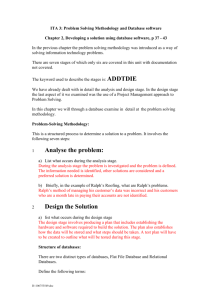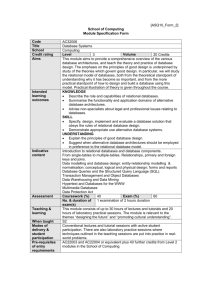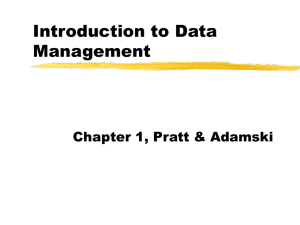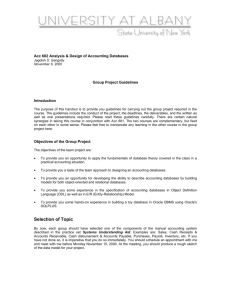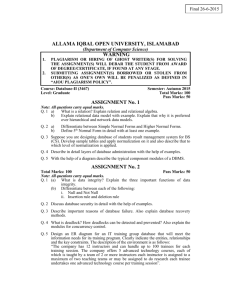Form & Database design basics
advertisement
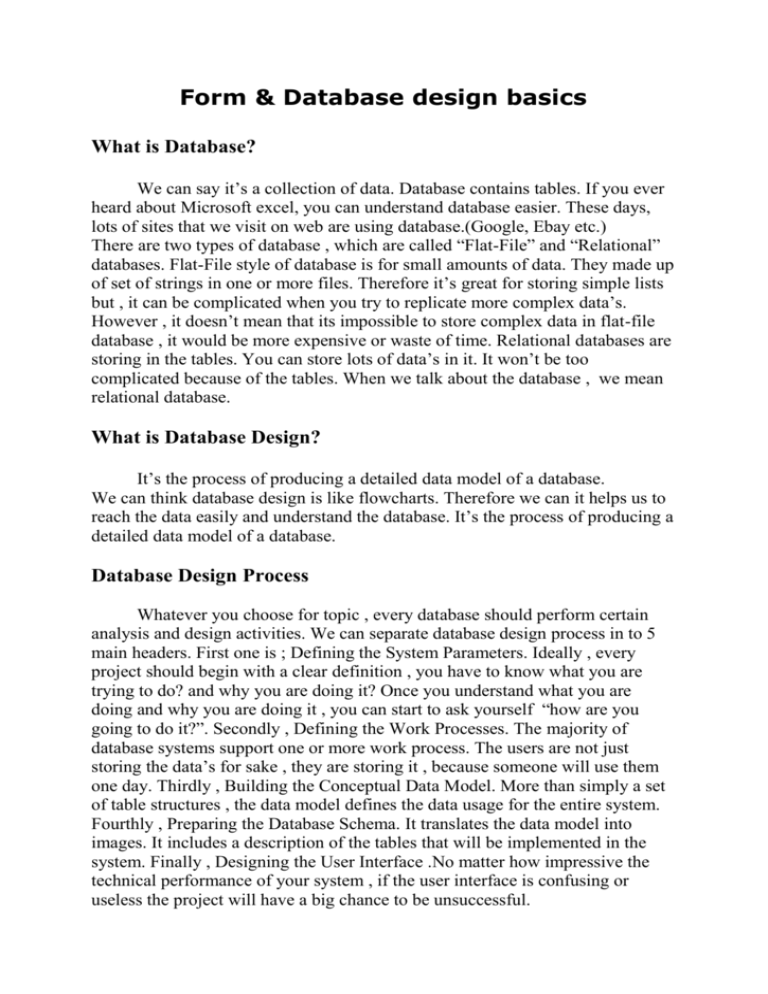
Form & Database design basics What is Database? We can say it’s a collection of data. Database contains tables. If you ever heard about Microsoft excel, you can understand database easier. These days, lots of sites that we visit on web are using database.(Google, Ebay etc.) There are two types of database , which are called “Flat-File” and “Relational” databases. Flat-File style of database is for small amounts of data. They made up of set of strings in one or more files. Therefore it’s great for storing simple lists but , it can be complicated when you try to replicate more complex data’s. However , it doesn’t mean that its impossible to store complex data in flat-file database , it would be more expensive or waste of time. Relational databases are storing in the tables. You can store lots of data’s in it. It won’t be too complicated because of the tables. When we talk about the database , we mean relational database. What is Database Design? It’s the process of producing a detailed data model of a database. We can think database design is like flowcharts. Therefore we can it helps us to reach the data easily and understand the database. It’s the process of producing a detailed data model of a database. Database Design Process Whatever you choose for topic , every database should perform certain analysis and design activities. We can separate database design process in to 5 main headers. First one is ; Defining the System Parameters. Ideally , every project should begin with a clear definition , you have to know what you are trying to do? and why you are doing it? Once you understand what you are doing and why you are doing it , you can start to ask yourself “how are you going to do it?”. Secondly , Defining the Work Processes. The majority of database systems support one or more work process. The users are not just storing the data’s for sake , they are storing it , because someone will use them one day. Thirdly , Building the Conceptual Data Model. More than simply a set of table structures , the data model defines the data usage for the entire system. Fourthly , Preparing the Database Schema. It translates the data model into images. It includes a description of the tables that will be implemented in the system. Finally , Designing the User Interface .No matter how impressive the technical performance of your system , if the user interface is confusing or useless the project will have a big chance to be unsuccessful. Tables Think of it’s as being like a rectangular spreadsheet made up of rows and columns. Each column specifies the type of data stored such as numbers or strings. We can also think like in c or c++, array of structs. Query A database query is a request for information from a database such as “What course are u taking?” All queries are intended to return o list of devices. What is a database form? A database form can be used to facilitate database data entry and retrieval operations. A database developer usually designs a form which can then be used by personal without any specific database skills to perform repetitive tasks. Primary Key The primary key of a relational table uniquely identifies each record in the table. For example someone might create codes such as TLC for the Laser Club and JS for Jone Services. At first, this my seem like a good idea the codes are short and by looking at them you can figure out which distributes they reference .But what happens if one of the companies changes its name? For this reason Avoiding meaningful primary key. Normalization Normalization is a process of organizing the data in database in more efficient way. It is main goal is designing relational tables to minimize repeating tables and information. This process protects the database against structural problem. First Normal Form Eliminate repeating groups. In my example there are people who knows different database programs, some of them might know more than one. If we ask a question “who knows access” we have to scan the whole list for references to access. This is in efficient, so moving the know databases into a separate table can solve our problem. Separating the repeating groups of databases from the member information results in first normal form. Second Normal Form Eliminate redundant data. In my database table primary key is member ID and database ID but the same database name appear redundantly every time its ID appears in the database table. For example if you want to reclassify a database or give it databases ID then you have to change it for every member that is listed in that database. To avoid this problem we have to separate the attributes depending on database ID. So we create two tables. Database table which gives name for each database and member database which lists the database for each member. This is called eliminate redundant data. Third Normal Form Eliminate columns not dependent on key .When we need to add more information in our database such as company name or company location it might cause a problem, because our key is member ID but the company name and company location describes only a company not a member so to achieve third normal form we have to move this data to anew table. When we create company table then company code becomes the key of new company table .This separation makes our database more efficient because when we want to change a company location or something like this. We only need to change the location column in company table. Otherwise we had to change whole company location data in member table. What Can a Form Designer Do? Get the point : You may be asking for too much information. Users are reluctant to volunteer information, especially if what you're asking for seems irrelevant. Add help information : Help the user with tool tip text. Provide a clear confirmation message :You should clearly confirm that the form has been received - send them to a receipt message display on a Web pages. Warning Message : In order to use warning message with msgbox or another page , we use clear information down to the textbox, label , checkbox ext, or we use a link for guide the user. Can MENTEŞ Ahmet Korhan ZIVRALI




